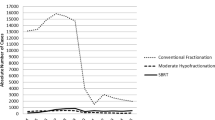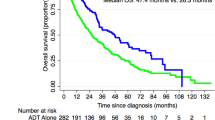Abstract
Background:
Recent studies have shown a decrease in the overall use of radiation therapy in the treatment of prostate cancer over the past several decades, as well as a more conservative overall treatment approach. We aim to determine whether this trend continued from 2004 to 2013, and to determine whether there were changes in utilization for various types of radiation.
Methods:
We conducted this retrospective study using the National Cancer Database. We identified 706 877 patients with sufficient treatment information diagnosed with stage IIA prostate cancer between 2004 and 2013. Logistic regression models were used to evaluate the yearly trend in radiation therapy utilization.
Results:
There was a significant decline in the use of radiation therapy from 2004 to 2013, from 54.4% in 2004 to 34.5% in 2013 compared with all the other treatments. The use of external beam radiation therapy (EBRT) declined from 27.1% in 2004 to 25.0% in 2013, brachytherapy declined from 19.7% in 2004 to 6.1% in 2013, and combination therapy declined from 6.8% in 2004 to 2.6% in 2013. However, when considering only patients receiving radiation treatments, the use of EBRT steadily increased from 50.6% in 2004 to 74.0% in 2013, whereas the use of brachytherapy declined from 36.7% in 2004 to 18.2% in 2013. Finally, although the proportion of patients receiving combination radiation therapy initially declined from 2004 to 2009 (from 12.7 to 8.3%), there was little change in utilization from 2009 to 2013 (8.3 to 8.5%).
Conclusions:
There has been a significant decline in the use of overall radiation therapy, as well as for each radiotherapy modality, for the treatment of prostate cancer since 2004. For patients that are receiving radiation, the use of EBRT has increased while brachytherapy use has decreased. These data serve to encourage further analysis as to the causes of these trends and how they affect patient care.
This is a preview of subscription content, access via your institution
Access options
Subscribe to this journal
Receive 4 print issues and online access
$259.00 per year
only $64.75 per issue
Buy this article
- Purchase on Springer Link
- Instant access to full article PDF
Prices may be subject to local taxes which are calculated during checkout

Similar content being viewed by others
References
Siegel RL, Miller KD, Jemal A . Cancer statistics, 2016. CA Cancer J Clin 2016; 66: 7–30.
Prostate. In: Edge S, Byrd D, Compton CC (eds). AJCC Cancer Staging Manual. Springer: New York, NY, USA, 2010, pp 457–486.
NCCN Clinical Practice Guidelines in Oncology: Prostate Cancer. Version 3.2016. National Comprehensive Cancer Network.
Jani AB, Johnstone PA, Liauw SL, Master VA, Rossi PJ . Prostate cancer modality time trend analyses from 1973 to 2004: a Surveillance, Epidemiology, and End Results registry analysis. Am J Clin Oncol 2010; 33: 168–172.
Hamilton AS, Albertsen PC, Johnson TK, Hoffman R, Morrell D, Deapen D et al. Trends in the treatment of localized prostate cancer using supplemented cancer registry data. BJU Int 2011; 107: 576–584.
Muralidhar V, Mahal BA, Ziehr DR, Chen YW, Nezolosky MD, Viswanathan VB et al. Shifting brachytherapy monotherapy case mix toward intermediate-risk prostate cancer. Brachytherapy 2015; 14: 511–516.
Mahmood U, Pugh T, Frank S, Levy L, Walker G, Haque W et al. Declining use of brachytherapy for the treatment of prostate cancer. Brachytherapy 2014; 13: 157–162.
Martin JM, Handorf EA, Kutikov A, Uzzo RG, Bekelman JE, Horwitz EM et al. The rise and fall of prostate brachytherapy: use of brachytherapy for the treatment of localized prostate cancer in the National Cancer Data Base. Cancer 2014; 120: 2114–2121.
Mettlin CJ, Murphy GP, McDonald CJ, Menck HR . The National Cancer Data base Report on increased use of brachytherapy for the treatment of patients with prostate carcinoma in the U.S. Cancer 1999; 86: 1877–1882.
Goyal G, Silberstein PT, Armitage JO . Trends in Use of Radiation Therapy for Hodgkin Lymphoma From 2000 to 2012 on the Basis of the National Cancer Data Base. Clin Lymphoma Myeloma Leuk 2016; 16: 12–17.
Bilimoria KY, Stewart AK, Winchester DP, Ko CY . The National Cancer Data Base: a powerful initiative to improve cancer care in the United States. Ann Surg Oncol 2008; 15: 683–690.
American Joint Committee on Cancer ACS, American College of Surgeons AJCC Cancer Staging Manual. Lippincott-Raven: Philadelphia, PA, USA, 1997.
Greene F, American Joint Committee on Cancer ACS AJCC Cancer Staging Manual. Springer-Verlag: New York, NY, USA, 2002.
Elliott SP, Adejoro OO, Konety BR, Jarosek SL, Dusenbery KE, Virnig BA . Intensity modulated radiation therapy replaces 3-dimensional conformal radiotherapy as prostate cancer treatment. J Urol 2012; 187: 1253–1258.
Lee DH, Jung HB, Chung MS, Lee SH, Chung BH . The change of prostate cancer treatment in Korea: 5 year analysis of a single institution. Yonsei Med J 2013; 54: 87–91.
Cary KC, Punnen S, Odisho AY, Litwin MS, Saigal CS, Cooperberg MR et al. Nationally representative trends and geographic variation in treatment of localized prostate cancer: the Urologic Diseases in America project. Prostate Cancer Prostatic Dis 2015; 18: 149–154.
Williams SB, Prasad SM, Weinberg AC, Shelton JB, Hevelone ND, Lipsitz SR et al. Trends in the care of radical prostatectomy in the United States from 2003 to 2006. BJU Int 2011; 108: 49–55.
Schostak M, Baumunk D, Jagota A, Klopf C, Winter A, Schäfers S et al. Time trends in prostate cancer surgery: data from an Internet-based multicentre database. BJU Int 2012; 109: 355–359.
Trabulsi EJ, Zola JC, Colon-Herdman A, Heckman JE, Gomella LG, Lallas CD . Minimally invasive radical prostatectomy: transition from pure laparoscopic to robotic-assisted radical prostatectomy. Arch Esp Urol 2011; 64: 823–829.
Quek RG, Ward KC, Master VA, Lin CC, Portier KM, Virgo KS et al. Association between urologist characteristics and radiation oncologist consultation for patients with locoregional prostate cancer. J Natl Compr Canc Netw 2015; 13: 303–309.
Kupelian PA, Potters L, Khuntia D, Ciezki JP, Reddy CA, Reuther AM et al. Radical prostatectomy, external beam radiotherapy <72 Gy, external beam radiotherapy>or =72 Gy, permanent seed implantation, or combined seeds/external beam radiotherapy for stage T1-T2 prostate cancer. Int J Radiat Oncol Biol Phys 2004; 58: 25–33.
Wolff RF, Ryder S, Bossi A, Briganti A, Crook J, Henry A et al. A systematic review of randomised controlled trials of radiotherapy for localised prostate cancer. Eur J Cancer 2015; 51: 2345–2367.
Mitchell JM . Urologists' use of intensity-modulated radiation therapy for prostate cancer. N Engl J Med 2013; 369: 1629–1637.
Petereit DG, Frank SJ, Viswanathan AN, Erickson B, Eifel P, Nguyen PL et al. Where have you gone, brachytherapy? J Clin Oncol 2015; 33: 980–982.
Shah C, Lanni TB, Ghilezan MI, Gustafson GS, Marvin KS, Ye H et al. Brachytherapy provides comparable outcomes and improved cost-effectiveness in the treatment of low/intermediate prostate cancer. Brachytherapy 2012; 11: 441–445.
Grant SR, Walker GV, Koshy M, Shaitelman SF, Klopp AH, Frank SJ et al. Impact of insurance status on radiation treatment modality selection among potential candidates for prostate, breast, or gynecologic brachytherapy. Int J Radiat Oncol Biol Phys 2015; 93: 968–975.
Buyyounouski MK, Davis BJ, Prestidge BR, Shanahan TG, Stock RG, Grimm PD et al. A survey of current clinical practice in permanent and temporary prostate brachytherapy: 2010 update. Brachytherapy 2012; 11: 299–305.
Malik R, Oh JL, Roeske JC, Mundt AJ . Survey of resident education in intensity-modulated radiation therapy. Technol Cancer Res Treat 2005; 4: 303–309.
Cooperberg MR, Carroll PR . Trends in management for patients with localized prostate cancer, 1990-2013. JAMA 2015; 314: 80–82.
Berrington de Gonzalez A, Wong J, Kleinerman R, Kim C, Morton L, Bekelman JE . Risk of second cancers according to radiation therapy technique and modality in prostate cancer survivors. Int J Radiat Oncol Biol Phys 2015; 91: 295–302.
Mohammed N, Kestin L, Ghilezan M, Krauss D, Vicini F, Brabbins D et al. Comparison of acute and late toxicities for three modern high-dose radiation treatment techniques for localized prostate cancer. Int J Radiat Oncol Biol Phys 2012; 82: 204–212.
Moon DH, Efstathiou JA, Chen RC . What is the best way to radiate the prostate in 2016? Urol Oncol 2016; 35: 59–68.
Jacobs BL, Zhang Y, Skolarus TA, Hollenbeck BK . Growth of high-cost intensity-modulated radiotherapy for prostate cancer raises concerns about overuse. Health Aff (Millwood) 2012; 31: 750–759.
Author information
Authors and Affiliations
Corresponding author
Ethics declarations
Competing interests
The authors declare no conflict of interest.
Additional information
This study was presented in part at the 58th Annual Meeting of the American Society for Radiation Oncology, 25–28 September 2016, Boston, MA, USA.
DISCLAIMER
The data used in the study are derived from a de-identified NCDB file. The American College of Surgeons and the Commission on Cancer have not verified and are not responsible for the analytic or statistical methodology used, nor the conclusions drawn from these data by the investigator.
Rights and permissions
About this article
Cite this article
Malouff, T., Mathy, N., Marsh, S. et al. Trends in the use of radiation therapy for stage IIA prostate cancer from 2004 to 2013: a retrospective analysis using the National Cancer Database. Prostate Cancer Prostatic Dis 20, 334–338 (2017). https://doi.org/10.1038/pcan.2017.15
Received:
Revised:
Accepted:
Published:
Issue Date:
DOI: https://doi.org/10.1038/pcan.2017.15
This article is cited by
-
Changing nationwide trends away from overtreatment among patients undergoing radical prostatectomy over the past 25 years
World Journal of Urology (2023)
-
Is it worth to perform salvage radical prostatectomy for radio-recurrent prostate cancer? A literature review
World Journal of Urology (2019)



